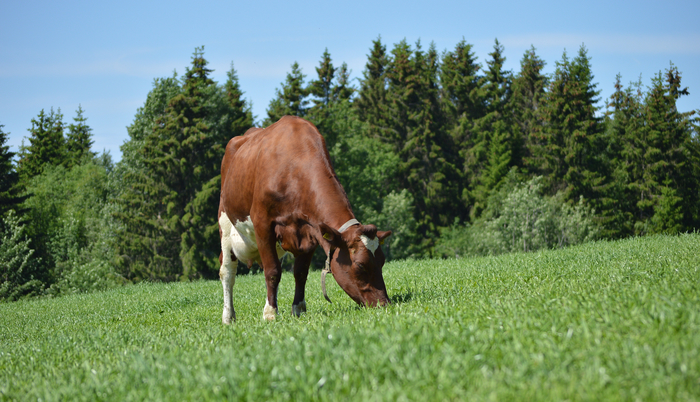Norway’s cattle breeding organisation Geno is introducing a new breeding trait, Feed$aved, in March 2021. It has been developed to assist dairy farmers in identifying Norwegian Red genetics with improved feed efficiency.
Based on feed intake and body weight maintenance, the Feed$aved triat will help to breed cows in crossbred and purebred herds with lower feed intakes without compromising milk value.
Geno has taken advantage of the Norwegian national cattle database, that holds on-going records on 93% of its cows, to track the weights of 1.2 million cows. These weights are used to estimate dry matter intakes required for body weight maintenance.
“We have used this data to develop a breeding value for body weight and for Feed$aved fro Norwegian Red sires,” says Geno’s chief technology and innovation officer Håvard Tajet. “The large numbers of records available and the high heritability of body weight, at 0.47, means that both breeding values are highly accurate.
“The genetics linked to lower feed intakes, where body weight and milk yield are maintained, have been identified and the information has been used in developing the new Feed$aved trait,” adds Dr Tajet.
It is well-recognised that smaller, lighter cows will require less feed for maintenance. The Norwegian Red is a moderately sized dairy breed, with an average mature body weight of 610kg compared with the Holstein at 700kg. The average body weight of a Norwegian Red x Holstein crossbred is therefore 655kg. “So as the industry focuses on improved feed efficiency and sustainability, the Norwegian Red already has advantages,” he adds.
“However, like all breeds, there is a wide variation within the breed. Geno’s project has allowed us to identify the genetics linked to smaller, more efficient cows.”
Geno Global is promoting the trait, that is expressed as a Predicted Transmitting Ability (PTA), in its international markets and particularly in the UK and US where the industry is actively looking to breed smaller, more feed efficient dairy cattle.
The average PTA for the new Feed$aved trait is 0.65kg which indicates that the average Norwegian Red sire, when crossed with a 700kg cow – which is the base weight used in this trait – will produce daughters that will eat 0.65kg less dry matter a day due to her smaller body weight.
However, the top Norwegian Red sires for Feed$aved have a PTA slightly over 1kg. A crossbred daughter by one of these sires and out of an average Holstein dam is estimated to eat 1kg or less per day than a purebred Holstein due to her smaller body weight. This will reduce feed costs, without compromising milk value, leading to greater efficiency.
Data shows that the Norwegian Red x Holstein crossbred milk value will be within one or two percent for fat and protein production, and between five or six percent for milk volume of the purebred Holstein.
In general, body weight has a low correlation with other key traits that farmers will typically select for, and so selecting for low body weight will not compromise these other traits. Farmers are encouraged to use the Feed$aved trait with additional selection criteria in their programmes that will contribute to meeting their breeding goals.
“Improving feed efficiency will reduce the cost of overall production and increase profit, while at the same time contributing to a sustainable global dairy production,” says Dr. Tajet.
The Feed$aved trait is part of Geno’s feed efficiency breeding project that is researching the influence of genetics on sustainable and profitable milk production. It is also measuring and monitoring methane emissions from Norwegian Red cows and on young bulls.
“Our goal is to develop a comprehensive and reliable feed efficiency index for farmers to use as a selection tool in Norwegian Red purebred and crossbreeding programmes globally,” he adds.


